What Is SERP Volatility?
Volatility is defined as a liability to change, often unpredictably and for the worse.
SERP volatility (search engine results page volatility) measures the overall amount of change happening to search engine results.
For SEOs, volatility is synonymous with stress and anxiety. A feeling that at any moment, all of your hard work could be in vain, as Google replaces your page ranking at the top of the results with another.
What Does This Mean for You and Your Website?
In short, high SERP volatility, along with competition, can be the biggest obstacle to maintaining consistent results and expectations from your SEO efforts.
What Can You Do?
The best way to fight this volatility is with a tool like the Semrush Sensor. This tool tracks the volatility of Google’s SERPs on a daily basis and provides a volatility score to quantify the level of fluctuations each day. It’s like a weather report for Google’s results pages.
You can use the Semrush Sensor to:
- Measure overall SERP volatility per industry (news, jobs & education, shopping, law & government, etc.)
- Look into the volatility of SERP features like featured snippets, local packs, shopping results, reviews, and more
- Track the volatility of your custom set of target keywords by connecting a Position Tracking campaign

How to Monitor Google Algorithm Updates and Other SERP Changes
Some volatility is normal. As website owners and marketers use SEO and add new content to the web, the old results will get shaken up as Google finds the best page to rank.
But high volatility could be a sign of a major change to Google’s ranking algorithm.
Semrush Sensor has a daily volatility score, measuring the fluctuations on desktop or mobile SERPs for any of 25 categories (industries) in 9 countries over the last 30 days.
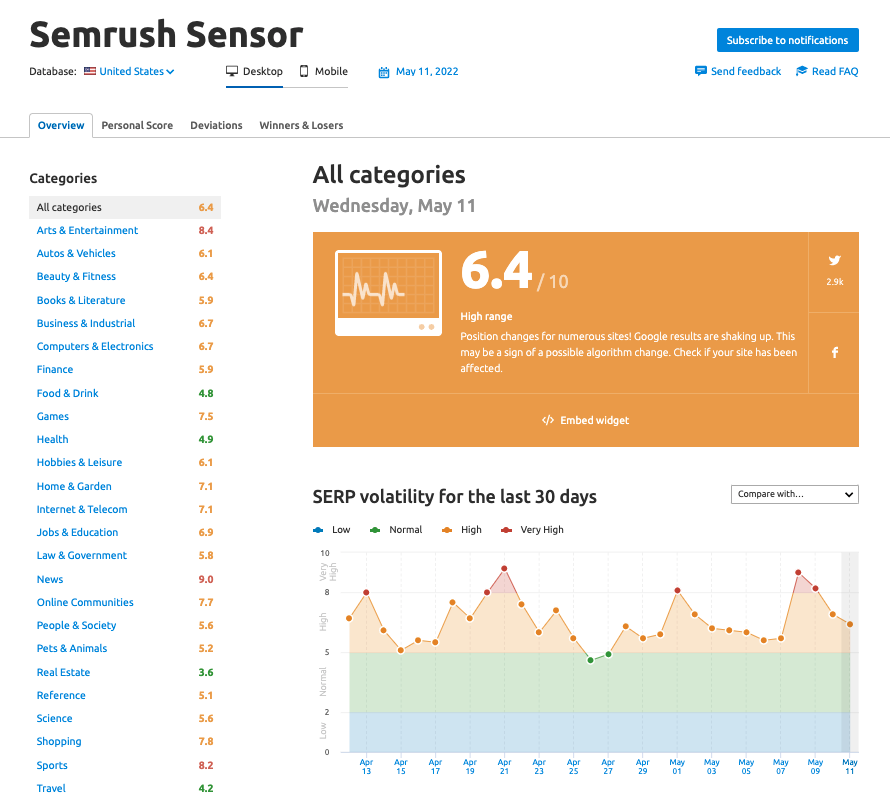
The values, calculated using a proprietary formula, are scaled 0-10 where:
- 0-2 = low
- 2-5 = average
- 5-8 = high
- 8-10 = very high
High and very high scores usually indicate a major search algorithm update or a set of penalties put out in force.
Keep Up with Sensor Notifications
To keep abreast of the volatility spikes, you can subscribe for notifications or embed the Sensor widget right into your website and start every morning with a SERP weather forecast.
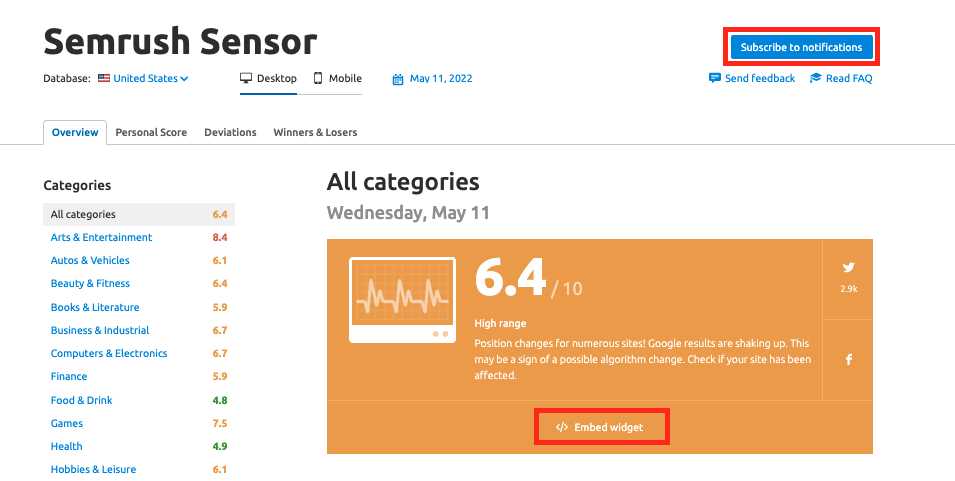
Tip: If you see an unexpected change in your rankings and no volatility deviation, we recommend that you audit your website for technical issues and your backlink profile for toxicity.
How to Analyze the Impact of Fluctuations on the SERPs
When you first become aware of a major fluctuation in the SERPs, you’ll want to dive into two things:
- How is this impacting my site?
- How widespread is the volatility (is it a major update impacting my whole niche/industry)?
See How an Update Impacts Your Site
You can get a precise look at how much volatility your site is experiencing when you create and connect a Position Tracking campaign to Semrush Sensor.
Once you connect that campaign, you’ll be able to access your Personal Score in Sensor. This will tell you how volatile the SERPs are for just your list of target keywords in your target area and device type.
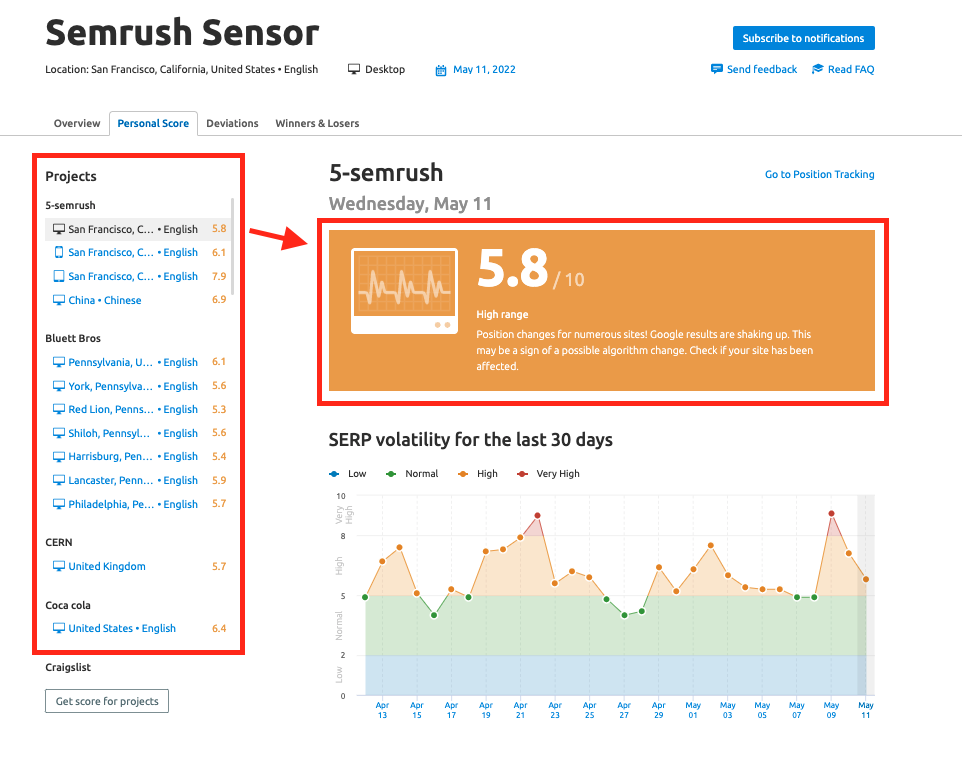
If you have multiple Semrush Projects set up with Position Tracking for every site you work on, you can see all of the Personal Scores listed in this tab on the left-hand side.
If you’re tracking the same website and keywords across multiple devices or locations, you can toggle each location/device’s volatility report, as seen below.

See How Widespread the Volatility Is
After checking on your site, you might want to know how widespread this volatility is. Did it only affect your industry, or are SEOs everywhere in panic mode?
Of course, the categories listed on the Sensor homepage will give you an idea of which industries were hit hardest with a Google update, or if volatility is higher in specific sectors, like News compared to Real Estate in this image:
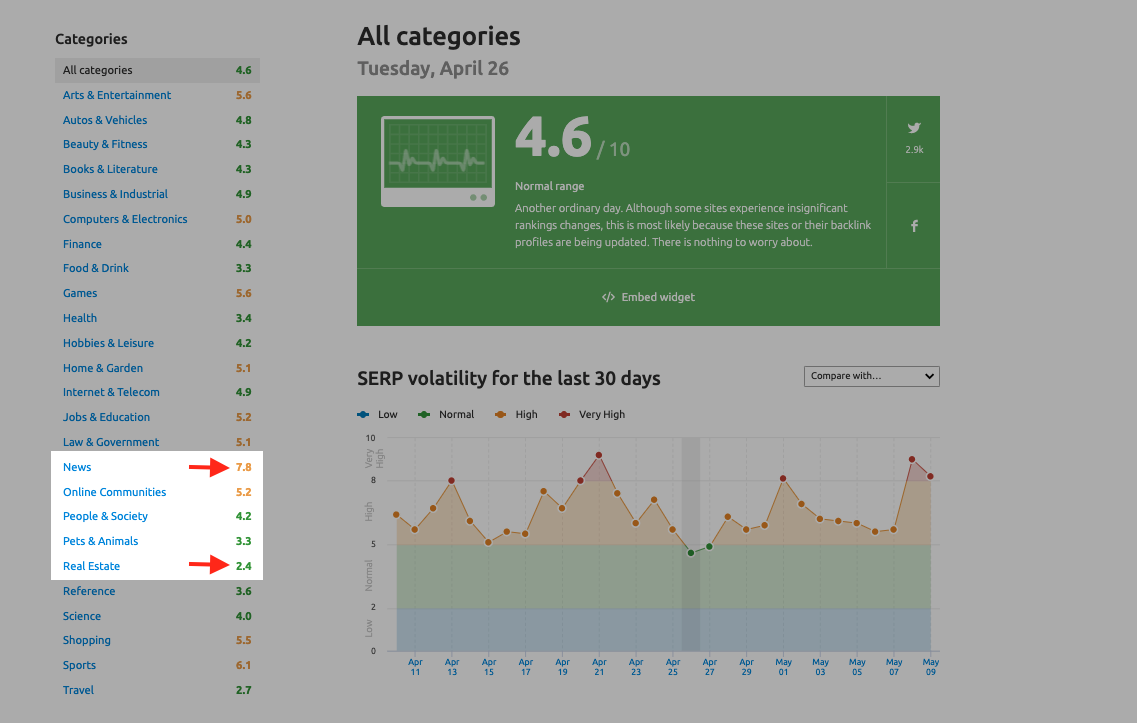
You can check whether the rankings are shuffling in just one country, or across the globe with the regional filters.
The “Compare with…” filter allows you to benchmark the volatility in different countries, or between different devices, projects, SERP features, etc. This is helpful if your business provides services to several industries, e.g. services in travel and real estate dealers.
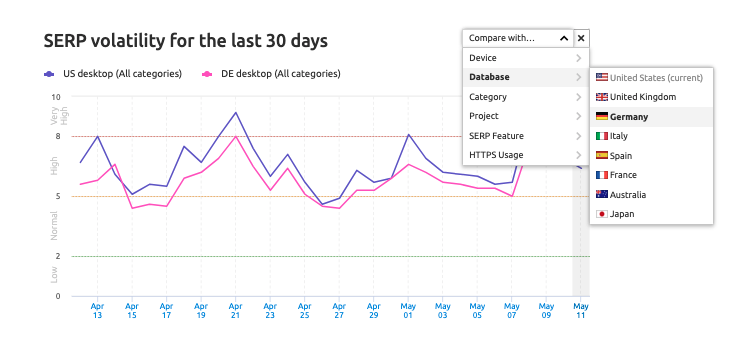
Look out for SERP Features Movement
Next, you can check out the presence of SERP Features and HTTPS. Just like the volatility score, you can view this info for all categories, or toggle each category to see how common each SERP Feature is across different industries.

You’ll see whether any new SERP features appear in your category, and how many websites in the top 20 are using HTTPS vs HTTP.
The results are shown for the Top 20 of the current day. The positive or negative difference from the previous day is shown in green or red. With this data, you can make informed decisions on migrating your website, creating its AMP version, or updating your content to target specific SERP features.
Tip: The importance of a specific SERP feature may vary depending on the industry (category). For instance, Top Stories are far more important to the News industry than the Local Pack.
To learn more about the feature you plan to target, click on the occurrence % to see the monthly trend graph for the chosen SERP feature.

How to Keep Your SEO Strategy Effective and Up to Date
The last and most important step is to react to the volatility and benefit from it. Here are a few things that you can do.
Checking Whether Your Rivals Are Affected by Volatility
If you have Position Tracking set up for your competitors’ websites you can use the “Compare with Project” filter. It lets you check the impact of the algorithm update on their rankings compared to the category as a whole. Choose a more aggressive SEO strategy if the SERP is on your side.

In the same way, you can use the “Compare with SERP feature” filter to check if the Featured Snippet (or any other SERP feature) you have achieved is subject to fluctuations, etc.
Exploring Deviations
In the Deviations tab, you’ll find data about the days when volatility was extremely high or low compared to the monthly average.
You can use this report to analyze a particularly volatile industry or attribute some changes in your rankings to the day when an update was rolled out.
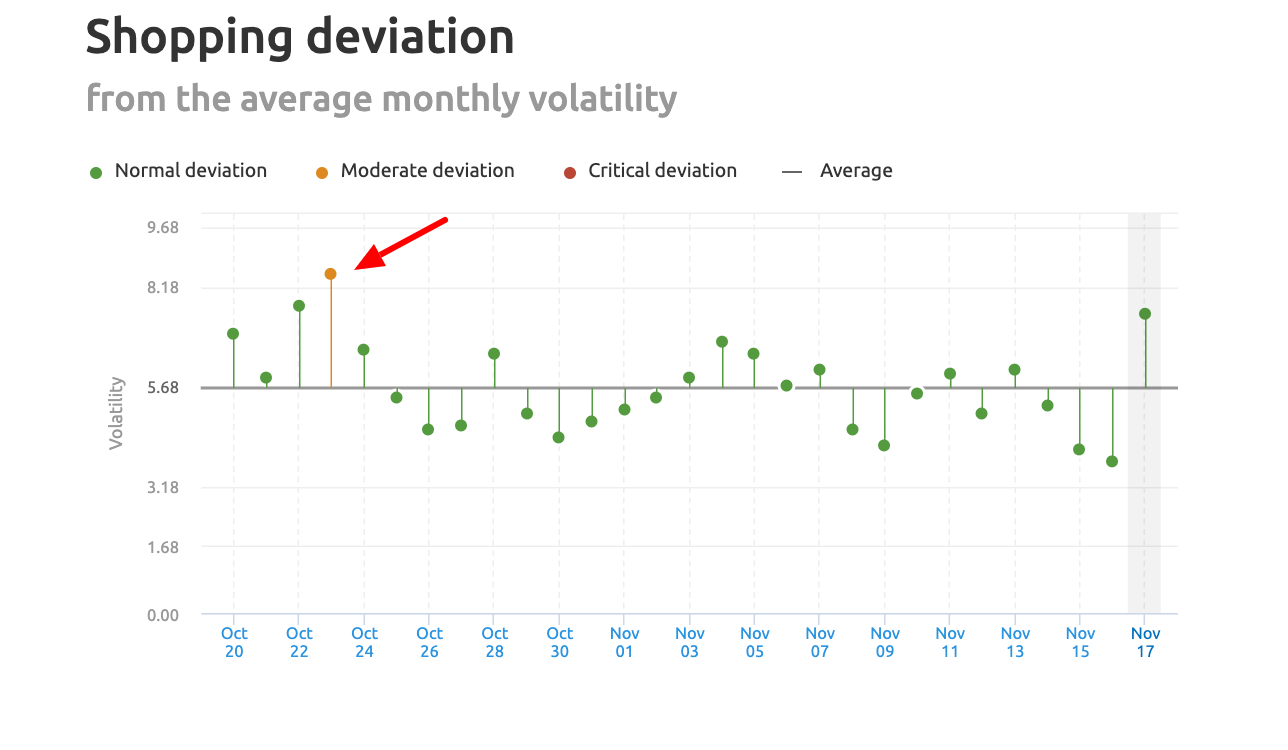
Analyzing Winners and Losers
The Winners and Losers report tells which domains in Google’s Top 20 daily suffer or gain from the SERPs’ volatility in terms of positions, as well as new and lost keywords. Use this data to find industry leaders, see how they cope with volatility, and find some content optimization ideas.
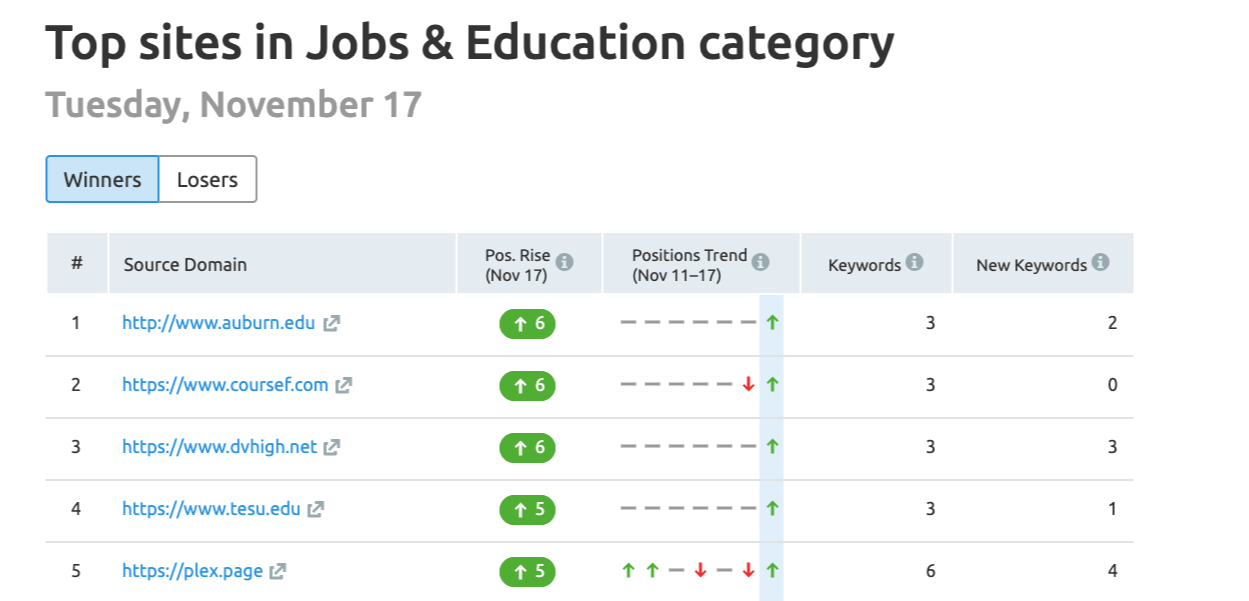
How Often Does Google Change its Algorithm?
Google is constantly updating its ranking algorithm as search behavior and trends evolve. According to John Mueller, these updates can happen on a daily basis.
However, there’s a difference between minor, everyday updates, and the more major significant updates that are officially confirmed as Core updates. Some of google’s Core updates include the Penguin update in 2012 and the Page Experience update in 2021.
It’s common for SEOs to take to Twitter to share signs of volatility from Semrush Sensor and ask around if others are seeing volatility with their sites’ rankings.
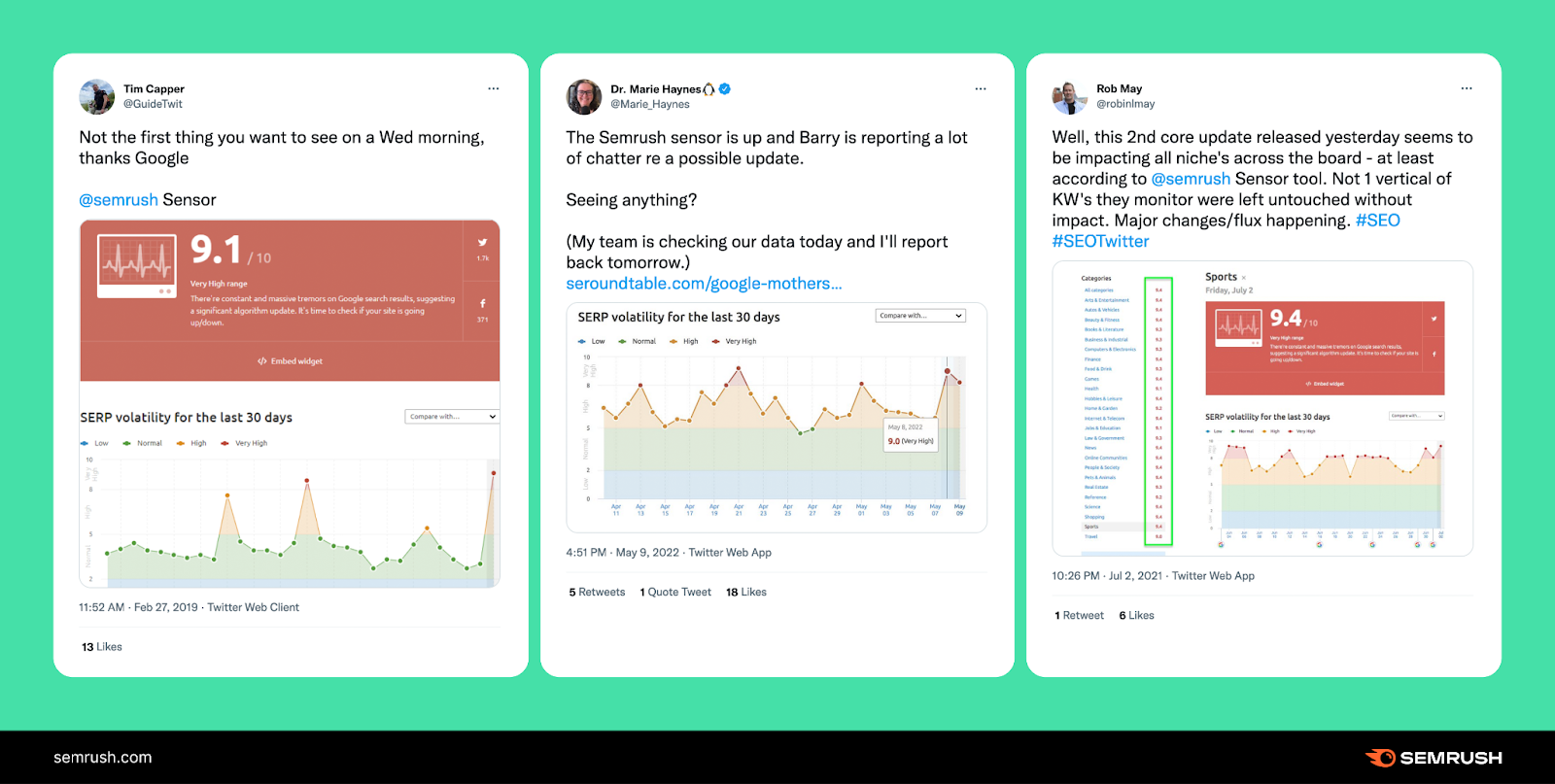
Core updates tend to have a higher impact on volatility across industries than everyday minor updates.
While Google’s innovation with its algorithm can be good for improving the user experience on the web, it can add uncertainty to the life of an SEO.
Staying up to date with the latest movements on the SERPs with notifications from Semrush Sensor can help mitigate this uncertainty.
When Was the Last Google Algorithm Change?
As we said, Google is changing its algorithm every day. However, no two algorithm updates are the same. Subscribe to Sensor notifications to know whenever early signs of a Core algorithm update appear.
If you want to see a compiled list of recent Core algorithm updates, you can reference our Notes. With Semrush Notes, you can keep track of updates related to:
- Confirmed Google updates (organic and paid)
- Unconfirmed Google updates
- Semrush data imports and periodic recrawls
- Semrush Sensor seeing high volatility
- Your own personal notes

This report can be filtered and exported to save as a resource.
Your All-Weather Friend
Semrush’s Sensor is much more than a way to detect SERP volatility and Google ranking algorithm updates. With the Sensor in your toolbox, you can:
- Analyze SERP features trends in up to 25 industry categories
- Know the volatility of your exact set of target keywords
- See how well your website “weathers the storm” of high volatility compared to rivals
- Explore the general state of a new target category
If you have any questions, read more about the Semrush Sensor on our Knowledge Base.
